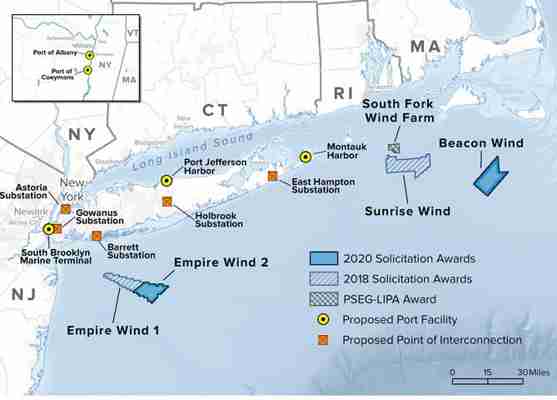New York City is making a big investment in renewable energy that will literally change the city’s landscape. Last week, Mayor Bill de Blasio announced plans for a $191 million investment in offshore wind turbines that will help the city reach a goal of 100% clean electricity production by 2030 and reaching full carbon neutrality by 2050. Developed in collaboration with the New York City Economic Development Corporation, the Offshore Wind Vision plan promises to reduce 34.5 million tons of carbon dioxide, the equivalent of removing 500,000 cars from Manhattan streets, while generating 13,000 jobs and $1.3 billion in average annual investments.
“The climate crisis is real,” De Blasio said in a release. “New York City will serve as the model for taking climate action and growing the offshore wind industry with a real long-term vision plan focused on equity. We have the opportunity now to deliver on promises and set the city on a path towards a sustainable future.”

A map showing both planned and existing wind turbine “farms” in the New York City area.
New York Senator Charles Schumer praised de Blasio for understanding that “transforming our energy system will drive our economy to new heights.”
“This forward-looking plan to grow the offshore wind industry sets New York City up to reduce emissions while creating good green jobs,” the Senate Majority Leader said in the statement. To ensure the program benefits the city and its residents while still providing safe and renewable energy, the Economic Development Corporation will establish an advisory council composed of community, business, scientific, and environmental-justice leaders. 40% of jobs and investments will be directed toward women, minorities, and environmental justice communities.
Brooklyn Borough President Eric Adams boasted the infrastructure was already in place to create wind manufacturing hubs at Brooklyn Navy Yard, South Brooklyn Marine Terminal, and the Red Hook Container Terminal. “Building the offshore wind industry from scratch has the potential to make our city more sustainable, more equitable, and more prosperous,” Adams said. “We must seize the opportunity before it blows away.”
Today, offshore wind generates less than 1 % of the world’s electrical power. But according to the International Energy Agency, as countries look to reduce dependency on fossil fuels, the market will expand 15 fold and transform into a trillion dollar industry by 2040. The White House has set a national goal of 30 gigawatts of offshore wind by 2030, which would generate electricity for 10 million American homes while cutting 85 million tons of carbon dioxide emissions.
Offshore wind operations have taken off in Europe, but they’re still a recent arrival in the U.S.: Currently there are only a pair of small-scale operations—a two-turbine project near Virginia Beach , Virginia, and a five-turbine one off Block Island in Rhode Island . The first large-scale offshore project in the U.S. was only given green light this past May, when Vineyard Wind received approval for its $3 billion plan to place more than 60 G.E. Haliade-X turbines off the southern coast of Martha’s Vineyard and Nantucket, Massachusetts, in federal waters. When the 800-megawatt Vineyard Wind 1 farm is up and running in 2023, the company claims, its 853-foot towers will generate enough energy to power 400,000 houses—and reduce carbon emissions by over 1.6 million tons per year.
In his State of the State address in January , Governor Andrew Cuomo announced New York would break ground this year on two farms off the coast of Long Island, each with more than 90 turbines. One will be located about 20 miles off Jones Beach, New York, and the other 60 miles from Montauk Point, New York. Generating 2,400 megawatts of power, or four times the energy capacity of a typical coal plant, the farms will be the largest two wind energy projects in the country. “Don’t worry,” Cuomo said, “neither will be visible from the shore.”
New York State now has five offshore wind projects in various stages of active development, the largest pipeline in the nation. Their combined capacity will be more than 4,300 megawatts or almost half needed to meet the state’s goal of 9,000 megawatts by 2035.
